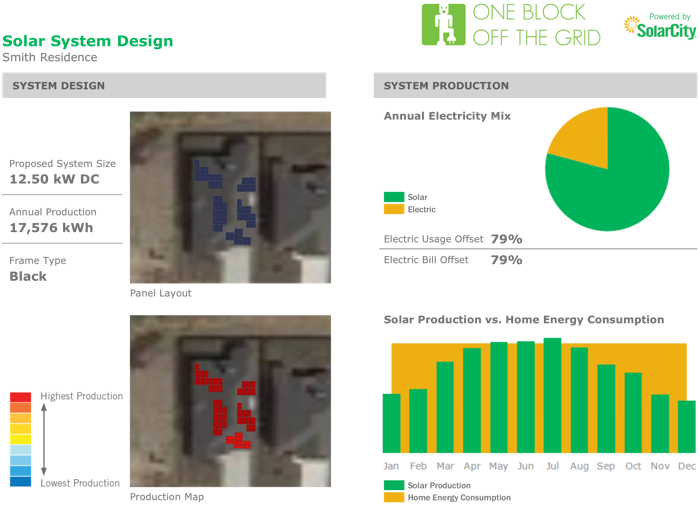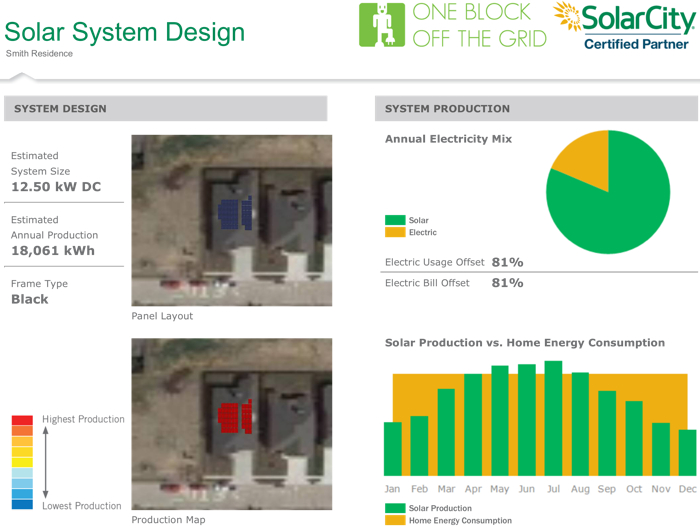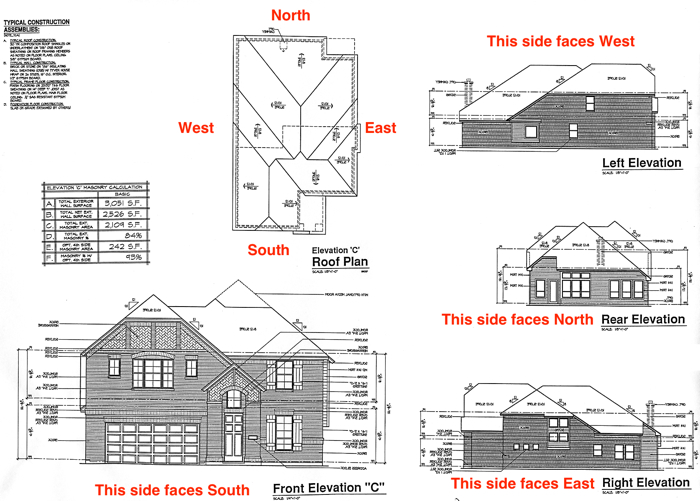As I mentioned in an earlier post, we are investigating getting solar panels for our new home. There seems to be a wide variation in how aggressive solar panel companies are, in relation to sales prospects. We had some we contacted that never contacted us again. The manufacturers would email us, asking how we felt about the local representative. Often, the manufacturer would be much more attentive than the company that would actually perform the installation.
One company that refused to drop the ball was One Block Off The Grid, representing SolarCity. From the first contact, our salesperson Todd, stayed on top of things. Our first contact was about 6 months before we closed on the new home. Todd stayed on top of things, like you’d expect from a professional salesperson. He was quite a contrast from the lackadaisical sales contacts we’d had from other providers.
Todd explained that One Block Off The Grid is a sales company working with SolarCity and that the system would cost the same, whether we went through OBOTG or dealt directly with SolarCity. Todd generated the first rough diagram of our solar panel system. This first pass was a large array that to be placed on the West-, South- and East-facing roofs and was guaranteed to generate 17,576 kWh per year. The final proposal was an interesting change. About three months had passed since the first proposal and we were surprised to see the array had been moved to only the East- and West-facing roof slopes but was guaranteed to produce even more energy! (18,061 kWh vs. 17,576 kWh) No explanation of how this was achieved was given to me, but my conclusion was that a newer generation of more efficient panels was used on the second design.
The final proposal was an interesting change. About three months had passed since the first proposal and we were surprised to see the array had been moved to only the East- and West-facing roof slopes but was guaranteed to produce even more energy! (18,061 kWh vs. 17,576 kWh) No explanation of how this was achieved was given to me, but my conclusion was that a newer generation of more efficient panels was used on the second design. We were concerned that the developer of our neighborhood might resist solar panels, if they were mounted on a roof side facing the street (South). In Texas, homeowner associations cannot ban solar panels outright. However, they can decide not to allow panels facing the street, unless it can be shown that system output would be reduced by 10% or more by enforcing the restriction. I was starting to relax about our chances of getting approved, when I read another part of the law: The only time a neighborhood association can ban solar panels, is when the development is still under constructions (as ours is). Well, we’ll do what we can do to get this project approved and moving forward.
We were concerned that the developer of our neighborhood might resist solar panels, if they were mounted on a roof side facing the street (South). In Texas, homeowner associations cannot ban solar panels outright. However, they can decide not to allow panels facing the street, unless it can be shown that system output would be reduced by 10% or more by enforcing the restriction. I was starting to relax about our chances of getting approved, when I read another part of the law: The only time a neighborhood association can ban solar panels, is when the development is still under constructions (as ours is). Well, we’ll do what we can do to get this project approved and moving forward.

 The satellite photo of the neighborhood that is available online, was taken before ground was broken on our home, so the house shown in their proposal is an existing home with the same orientation as ours. It was thought that would give them a way to generate the first solar panel layout and estimate.
The satellite photo of the neighborhood that is available online, was taken before ground was broken on our home, so the house shown in their proposal is an existing home with the same orientation as ours. It was thought that would give them a way to generate the first solar panel layout and estimate.
What originally attracted us to SolarCity was their financing plan. They will design, install, maintain and insure the system’s performance for twenty years, while we pay for the energy the system produces. They also insure the system against damage or loss. Depending on the size of the down payment, the energy price (per kWh) can increase at 2.5% per year (zero down payment) or be locked at a rate determined by our down payment. We decided we wanted a fixed energy rate, so we came up with a reasonable down payment. The last proposal quoted a rate of 6.8 cents per kWh. We had been paying Green Mountain Energy 10.7 cents per kWh at our last house and even when I was a Green Mountain Energy employee, my employee rate was higher than the rate we’ll pay for energy produced by the array. The savings should come close to covering the cost of charging both our Volts. Forever. Well, for at least 20 years…
Of course, those of you that know me, know that I created a spreadsheet to try to see what the impact of the panels (and their cost) would be. To come up with a decent estimate, we found 7 months’ worth of electricity usage figures for a woman that owns the same model of home that we do. I added to her figures the missing months, basing the energy usage of the missing months on the ratio of monthly energy usage for our previous home. We had detailed figures going back to 2004 and used the monthly average spread over all those years. I also used the first year of Blink charging data to determine how much energy our Volts would use, on average, for each month.
The usual argument against adopting solar power is the up-front system cost. With that eliminated, we thought, “Why not?” and signed up. The first real step, was an appointment where a SolarCity technician came out to our house and checked the attic, internet access and roof. Unfortunately for us, the appointment was at the tail-end of the ice storm of 2013 (as I’m sure it will come to be known and remembered). Most people didn’t leave home for four days. The technician tried to get up on the roof but finally decided to err on the side of caution and come back another day. Knowing Texas weather, if he waits a week, we’ll have highs in the 70’s or 80’s… They cannot develop the detailed panel layout until the technician can get on the roof, so all is at a standstill at the moment.
Now, what did I mean about “fragility” as mentioned in the title of this post? Several news articles have been published recently, showing that forces are gathering against wide-spread adoption of solar energy, in fact any renewable energy, by homeowners. In Arizona, the electric utility tried to kill “net metering” which requires electric utilities to purchase excess electricity generated by homeowners (although they can buy it at wholesale, rather than the retail price they charge us). Failing that first goal, they tried to get a fee of $100 per month levied on homeowners with solar panels. Finally, they settled on a $50 per year fee. Now honestly, what could be wrong with having energy companies buy surplus generated electricity at wholesale? It’s better for the environment and our country, doesn’t cost them a penny in infrastructure and diverts money away from non-renewable sources. In Texas specifically, it would seem that extra energy generated at the peak of air conditioner utilization would be a boon for these companies to buy at wholesale and sell at retail.
The problem with moves like these is they put doubt into the minds of those about to take the solar plunge. Many of these early adopters (if I can use that term for an industry that’s been around for 60 years) are making the leap of faith based primarily on doing what is right for the world and our country. In my case (and in my opinion), the savings are a motivator, but not the primary one. However, I cannot afford to ignore economics. If the system generates no return on investment, I could not afford to implement panels on our home.
If net metering goes away, investing in solar panels may be a fiasco for property owners. Homeowners considering such an investment, like all investors, want a market that is somewhat predictable. To get to the world we want, we need early adopters to take the risk, so we need to minimize said risk. Corporations just want to survive in their current form. We saw this with the music industry, while they grappled with Napster and later, iTunes/Apple. Unfortunately for power companies, the future is changing. Or is it fortunately? Why stagnate? Doesn’t everyone want to innovate and create new opportunities? Isn’t that the American dream? Companies that try to protect their current business model through legislation, at a time when the future is becoming apparent and their business model is becoming less viable, are not worthy of survival. Instead of creating television ads saying your an innovator, try innovating! These energy companies can act like record companies and see their world turned upside-down or they can plan ahead.
What I ask of my readers is this: Do not let us move backward, away from renewable energy sources. If ending renewable energy subsidies is proposed in your area, fight it or agree to an end to all energy subsidies. The anti-renewable energy crowd says that’s what they want, a level playing field. Based on the climate crisis ahead, giving them a level playing field may be overly generous, but my gut feel is that the other side in this argument would fight tooth-and-nail to prevent the loss of their subsidies.
We are still moving forward in our quest for solar panels. I’ll keep you updated on developments and results, once the array is installed.


Comments